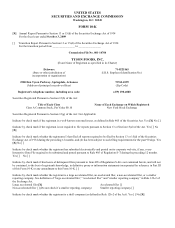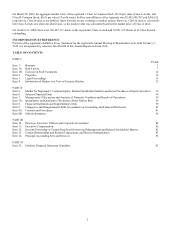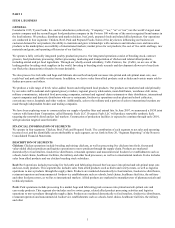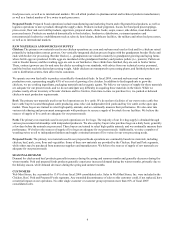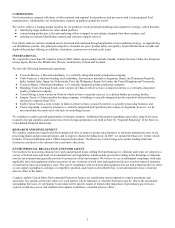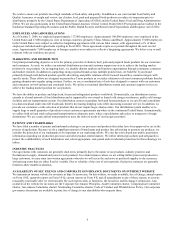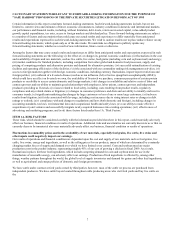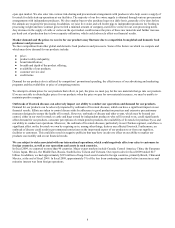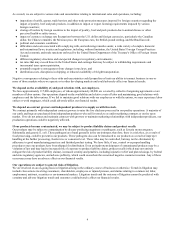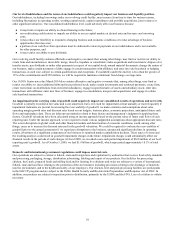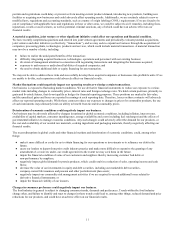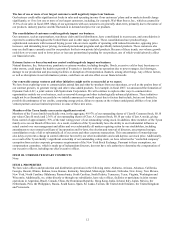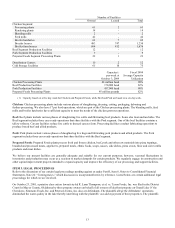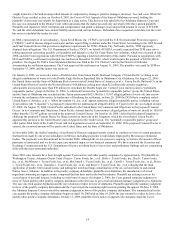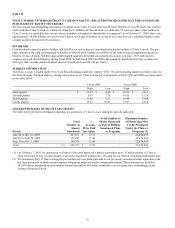Tyson Foods 2009 Annual Report Download - page 7
Download and view the complete annual report
Please find page 7 of the 2009 Tyson Foods annual report below. You can navigate through the pages in the report by either clicking on the pages listed below, or by using the keyword search tool below to find specific information within the annual report.7
CAUTIONARY STATEMENTS RELEVANT TO FORWARD-LOOKING INFORMATION FOR THE PURPOSE OF
"SAFE HARBOR" PROVISIONS OF THE PRIVATE SECURITIES LITIGATION REFORM ACT OF 1995
Certain information in this report constitutes forward-looking statements. Such forward-looking statements include, but are not
limited to, current views and estimates of future economic circumstances, industry conditions in domestic and international markets,
our performance and financial results, including, without limitation, debt-levels, return on invested capital, value-added product
growth, capital expenditures, tax rates, access to foreign markets and dividend policy. These forward-looking statements are subject
to a number of factors and uncertainties that could cause our actual results and experiences to differ materially from anticipated
results and expectations expressed in such forward-looking statements. We wish to caution readers not to place undue reliance on any
forward-looking statements, which speak only as of the date made. We undertake no obligation to publicly update any
forward-looking statements, whether as a result of new information, future events or otherwise.
Among the factors that may cause actual results and experiences to differ from anticipated results and expectations expressed in such
forward-looking statements are the following: (i) the effect of, or changes in, general economic conditions; (ii) fluctuations in the cost
and availability of inputs and raw materials, such as live cattle, live swine, feed grains (including corn and soybean meal) and energy;
(iii) market conditions for finished products, including competition from other global and domestic food processors, supply and
pricing of competing products and alternative proteins and demand for alternative proteins; (iv) successful rationalization of existing
facilities and operating efficiencies of the facilities; (v) risks associated with our commodity trading risk management activities; (vi)
access to foreign markets together with foreign economic conditions, including currency fluctuations, import/export restrictions and
foreign politics; (vii) outbreak of a livestock disease (such as avian influenza (AI) or bovine spongiform encephalopathy (BSE)),
which could have an effect on livestock we own, the availability of livestock we purchase, consumer perception of certain protein
products or our ability to access certain domestic and foreign markets; (viii) changes in availability and relative costs of labor and
contract growers and our ability to maintain good relationships with employees, labor unions, contract growers and independent
producers providing us livestock; (ix) issues related to food safety, including costs resulting from product recalls, regulatory
compliance and any related claims or litigation; (x) changes in consumer preference and diets and our ability to identify and react to
consumer trends; (xi) significant marketing plan changes by large customers or loss of one or more large customers; (xii) adverse
results from litigation; (xiii) risks associated with leverage, including cost increases due to rising interest rates or changes in debt
ratings or outlook; (xiv) compliance with and changes to regulations and laws (both domestic and foreign), including changes in
accounting standards, tax laws, environmental laws and occupational, health and safety laws; (xv) our ability to make effective
acquisitions or joint ventures and successfully integrate newly acquired businesses into existing operations; (xvi) effectiveness of
advertising and marketing programs; and (xvii) those factors listed under Item 1A. “Risk Factors.”
ITEM 1A. RISK FACTORS
These risks, which should be considered carefully with the information provided elsewhere in this report, could materially adversely
affect our business, financial condition or results of operations. Additional risks and uncertainties not currently known to us or that we
currently deem to be immaterial also may materially adversely affect our business, financial condition or results of operations.
Fluctuations in commodity prices and in the availability of raw materials, especially feed grains, live cattle, live swine and
other inputs could negatively impact our earnings.
Our results of operations and financial condition are dependent upon the cost and supply of raw materials such as feed grains, live
cattle, live swine, energy and ingredients, as well as the selling prices for our products, many of which are determined by constantly
changing market forces of supply and demand over which we have limited or no control. Corn and soybean meal are major
production costs in the poultry industry, representing roughly 45% of our cost of growing a chicken in fiscal 2009. As a result,
fluctuations in prices for these feed ingredients, which include competing demand for corn and soybean meal for use in the
manufacture of renewable energy, can adversely affect our earnings. Production of feed ingredients is affected by, among other
things, weather patterns throughout the world, the global level of supply inventories and demand for grains and other feed ingredients,
as well as agricultural and energy policies of domestic and foreign governments.
We have cattle under contract at feed yards owned by third parties; however, most of the cattle we process are purchased from
independent producers. We have cattle buyers located throughout cattle producing areas who visit feed yards and buy live cattle on
the

